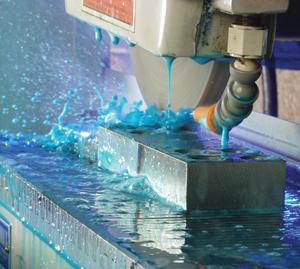- FMA
- The Fabricator
- FABTECH
- Canadian Metalworking
Understanding Grinding Fluid
Proper fluid use is more than just simply flooding the work area
- October 25, 2011
- Article
- Metalworking
Fluid use is very important in the grinding process because it reduces the effects of friction, removes heat from the work zone, and increases material removal. Most important, grinding fluid increases the material removal rate without increasing the damage to the surface of the workpiece.
Many cutting fluids are available today, so it is wise to choose the best option on the basis of application and material. With the goals being productivity improvement and cost reduction, shops must reduce scrap and create good, final parts. Properly selecting and applying grinding fluids can help manufacturers reach these goals.
“The fluid reduces friction by lubrication, either by chemical lubricity or by the use of an oil,” explained Master Chemical Corp. District Sales Manager for Canada David Foster. “The lubricity can be in the form of a lubricant that decreases the friction between the surfaces or it can act as a contaminant and reduce the shear stress in cutting.”
Grinding fluid also acts as a coolant, and even oil has some heat-transfer capability, but not as much as water-based coolants.
“Material removal is increased by the reduction in specific energy, which allows the stock removal rate to go up without increasing the surface damage to the workpiece,” said Foster.
Because the grinding process creates a lot of heat, flood coolant is most appropriate. However, it is equally important that the fluid be delivered where it is needed the most: at the point of cut.
“The application [method] of the fluid is very important; it should apply the fluid to the interface where it is needed the most,” said Foster. “Fluid application is not just a matter of bathing the area in fluid and assuming that it will be in the right place. The application method has to be engineered properly to ensure that the fluid is applied properly.”
Good final part quality relies on the fluid getting to the point of cut, in the correct volume, and at the proper velocity. Proper delivery allows the fluid to wet the wheel and the workpiece rapidly while providing the correct lubricity.
Examining the contact point is also important. The arc of contact in grinding is the portion of the circumference of the grinding wheel that is in contact with the workpiece. According to Foster, the longer the arc of contact, the more critical wetting becomes.
“The correct velocity also is very important. A lot of people will flood the grinding area, but this is actually not beneficial. The coolant should be moving at least as fast as the tool is moving at the point of cut for maximum benefit,” said Foster.

“The correct velocity also is very important. A lot of people will flood the grinding area, but this is actually not beneficial. The coolant should be moving at least as fast as the tool is moving at the point of cut for maximum benefit.” David Foster Master Chemical Corp.
Fluid Choice
In any grinding operation the type of wheel and wheel dressing also determine the type of fluid that should be used. If the wheel is dressed in a coarse manner for stock removal, then the important factor in the process is cooling. This makes a water-based fluid essential.
In the finishing process, a highly lubricious fluid is needed, or in some cases a straight oil, which is a highly sulfurized fluid. If cubic boron nitride (CBN) is being used, then there is no substitute for a straight oil, Foster advised.
“Some water-based fluids can work well, but this should be evaluated with respect to the overall economics of the process,” said Foster. “Many companies do not allow oil in the plant because the side effects can be increased mist in the shop atmosphere and the risk of fire.”
The basic functions of grinding fluids are very similar to those of other cutting fluids despite large differences between the dynamics of the process.
“In machining we tend to think that softer materials will benefit from higher lubricity and harder materials will require higher cooling capabilities. The same is true for grinding,” said Foster. “For example, grinding oil with active sulfur or chlorine will be effective in reducing heat generation and providing a good finish, but the cooling ability will be relatively poor.”
Management and Maintenance
Coolant management is important no matter what type of machining operation is being performed, but is especially important in grinding because of the small size of the chips, or swarf, coming off the workpiece, which can contaminate coolant very quickly. Proper coolant management will improve quality, increase productivity, decrease costs, and prevent excessive disposal.
“At the very basic level, proper mixing is important as are concentration checks using a refractometer and checking pH with paper strips,” said Foster. “Based on the size of a plant and the importance of its work, you can get into mixing units such as Master Chemicals’ UNIMIX™ to ensure proper concentration day in and day out.”
Maintaining coolant correctly after mixing also means understanding that evaporation will affect concentration levels. Ensuring the proper concentration levels are achieved and keeping the fluid clean will extend the life of the fluid. This is important in grinding applications because swarf can create bacteria growth in the fluid that will contribute to poor surface finishes. By using a refractometer, shops can quickly and easily check coolant dilution.
Other options include skimmers, coalescers, and complete fluid-recycling systems with centrifuges. Studies have shown that proper coolant management using a recycling system can reduce coolant costs by 40 to 60 percent, said Foster.
At its heart, good fluid management maximizes the fluid’s performance potential while actively maintaining it so it lasts as long as possible. Introducing proper fluid management techniques will help create a stable, consistent metalworking fluid.
Disposal methods for grinding fluids depend on the composition of the fluid being used. Shops should check their local or provincial authorities for best practice procedures.
subscribe now


Keep up to date with the latest news, events, and technology for all things metal from our pair of monthly magazines written specifically for Canadian manufacturers!
Start Your Free Subscription- Trending Articles
Automating additive manufacturing

Sustainability Analyzer Tool helps users measure and reduce carbon footprint

GF Machining Solutions names managing director and head of market region North and Central Americas

Mitutoyo updates its end-user portal

Enhance surface finish with high-speed machining

- Industry Events
CTMA Economic Uncertainty: Helping You Navigate Kitchener Seminar
- May 2, 2024
- Kitchener, ON Canada
Automate 2024
- May 6 - 9, 2024
- Chicago, IL
ANCA Open House
- May 7 - 8, 2024
- Wixom, MI
17th annual Joint Open House
- May 8 - 9, 2024
- Oakville and Mississauga, ON Canada
MME Saskatoon
- May 28, 2024
- Saskatoon, SK Canada
















